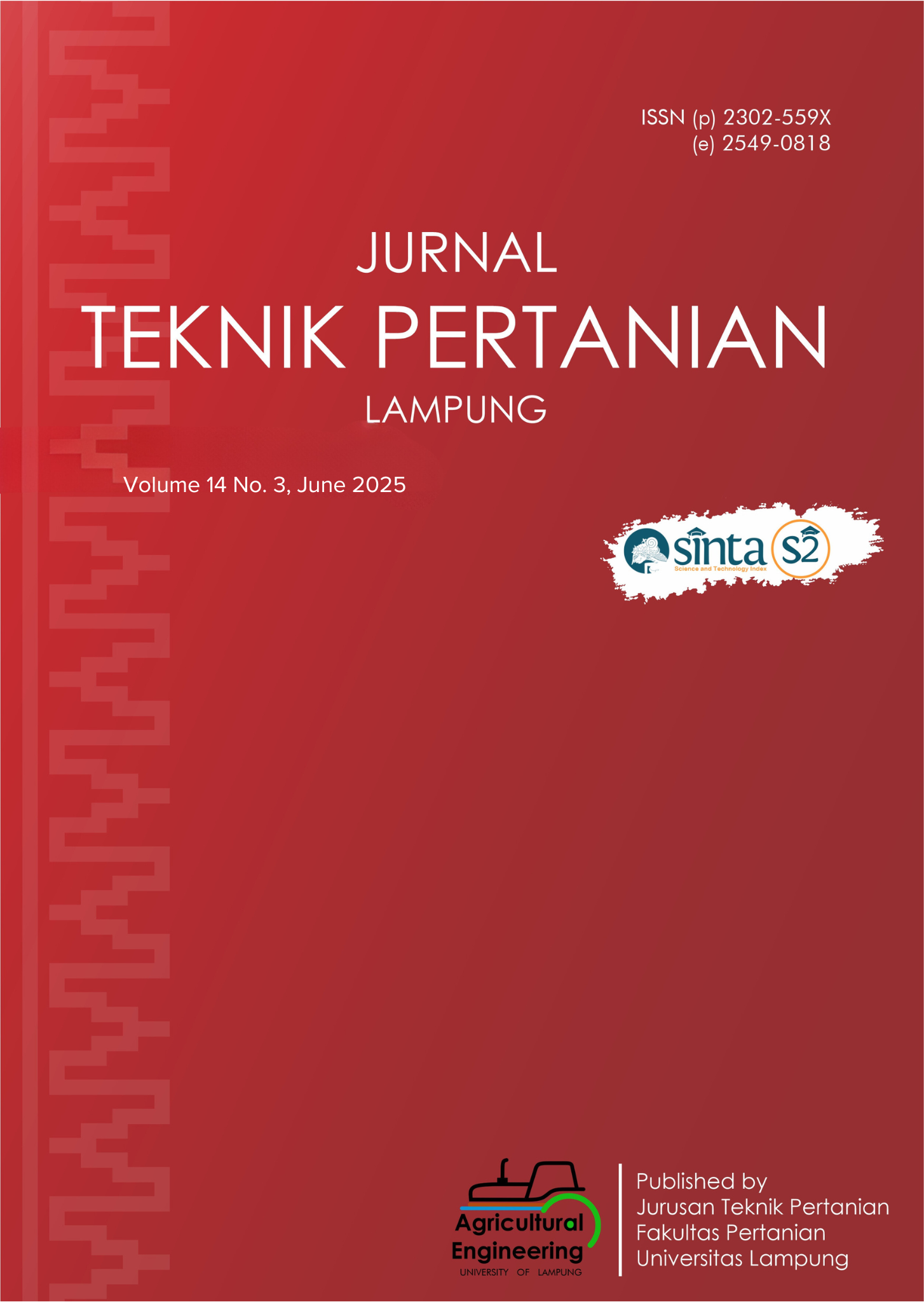Quality Assessment and Comparative Analysis of Malinau Coffee Among Indonesian Specialty Coffees
DOI:
https://doi.org/10.23960/jtep-l.v14i3.812-822 Abstract View: 328
Abstract View: 328
Abstract
Malinau Robusta coffee demonstrates untapped potential within the specialty coffee market. This study aims to evaluate the quality of Malinau coffee comprehensively and benchmark it against prominent specialty coffees such as Gayo, Toraja, and Kintamani. A descriptive quantitative method was employed to analyze critical parameters including caffeine content, moisture level, defect value, impurity level, grain size, and flavor profile. Coffee samples were gained from nine coffee-producing villages in Malinau Regency, involving 28 farmers covering 190 ha of coffee plantations. The results identified distinct strengths of Malinau coffee, notably its low moisture level (10.2%) and high caffeine content (1.94%) among the samples, offering a strong and intense flavor profile including chocolatey, a bitter aftertaste, and fruity undertones. Challenges for Malinau coffee includes high defect value (65.7/300 g) and impurity level (0.6%), which undermine its marketability in premium segments. To bring Malinau coffee up to par with other established specialty coffees, improvements in post harvest handling are needed, particularly sorting, quality control and consistent processes methods. By adopting innovative cultivation and processing, Malinau coffee holds strong potential as a competitor of specialty coffee, both for domestic and global markets while highlighting its unique regional identity.
Keywords: Malinau coffee, North Kalimantan, Quality improvement, Robusta, Specialty coffee.
Downloads
References
Agustina, R., Nurba, D., Antono, W., & Septiana, R. (2019). Pengaruh suhu dan lama penyangraian terhadap sifat fisik-kimia kopi Arabika dan kopi Robusta. Prosiding Seminar Nasional Inovasi Teknologi untuk Masyarakat, 285–299.
Al-Ghamdi, S., Alfaifi, B., Elamin, W., & Lateef, M.A. (2024). Advancements in coffee manufacturing: From dehydration techniques to quality control. Food Engineering Reviews, 16, 513-539. http://dx.doi.org/10.1007/s12393-024-09383-5
Angeloni, S., Mustafa, A.M., Abouelenein, D., Alessandroni, L., Acquaticci, L., Nzekoue, F.K., Petrelli, R., Sagratini, G., Vittori, S., Torregiani, E., & Caprioli, G. (2021). Characterization of the aroma profile and main key odorants of espresso coffee. Molecules, 26(13), 3856. http://dx.doi.org/10.3390/molecules26133856
Anhar, S., Rasyid, U.H.A., Muslin, A.M., Baihaqi, A., Roma, R., & Abubakar, Y. (2021). Sustainable Arabica coffee development strategies in Aceh, Indonesia. IOP Conference Series Earth and Environmental Science, 667(1), 012106. http://dx.doi.org/10.1088/1755-1315/667/1/012106
Aprilia, F.A., Ayuliansari, Y., Putri, T., Azis, M.Y., Camelina, W.D., & Putra, M.R. (2018). Analisis kandungan kafein dalam kopi tradisional gayo dan kopi lombok menggunakan hplc dan spektrofotometri UV-Vis. Biotika, 16(2), 38–39. https://doi.org/10.24198/bjib.v16i2.19829
Basalong, A.A., Amado, V.Y., & Talbino, H.L.B. (2020). Effects of the different postharvest processing methods on the occurrence of ochratoxin a and cupping quality of arabica coffee. Mountain Journal of Science And Interdisciplinary Research, 80(1), 87–97. https://doi.org/10.70884/mjsir.v80i1.267
Borrella, I., Mataix, C., & Carrasco‐Gallego, R. (2015). Smallholder farmers in the speciality coffee industry: Opportunities, constraints and the businesses that are making it possible. IDS Bulletin, 46(3), 29–44. http://dx.doi.org/10.1111/1759 5436.12142
Byrareddy, V., Kouadio, L., Mushtaq, S., & Stone, R. (2019). Sustainable production of Robusta coffee under a changing climate: a 10-year monitoring of fertilizer management in coffee farms in Vietnam and Indonesia. Agronomy, 9(9), 499. https://doi.org/10.3390/agronomy9090499
Cordoba, N., Fernandez-Alduenda, M., Moreno, F.L., & Ruiz, Y. (2020). Coffee extraction: A review of parameters and their influence on the physicochemical characteristics and flavour of coffee brews. Trends in Food Science & Technology, 96, 45 60. https://doi.org/10.1016/j.tifs.2019.12.004
Cortés-Macías, E.T., López, C.F., Gentile, P., Girón-Hernández, J., & López, A.F. (2022). Impact of post-harvest treatments on physicochemical and sensory characteristics of coffee beans in Huila, Colombia. Postharvest Biology and Technology, 187, 111852. https://doi.org/10.1016/j.postharvbio.2022.111852
da Silva, C.S., Coelho, A.P.de.F., Lisboa, C.F., Vieira, G., & Teles, M.C.de.A. (2022). Post-harvest of coffee: factors that influence the final quality of the beverage. Revista Engenharia Na Agricultura – REVENG, 30, 49-62. http://dx.doi.org/10.13083/reveng.v30i1.12639
Darwis, N.I.Z., Khalid, N.I.I., Dariyanti, E.W., Harun, M.A., & Rimantho, D. (2024). Kandungan flavonoid pada ampas kopi toraja untuk mengimpiskan jerawat pada remaja. Prosiding Seminar Nasional Pembangunan dan Pendidikan Vokasi Pertanian, 5(1), 1210–1221. https://doi.org/10.47687/snppvp.v5i1.1193
Das, P.P., Duarah, P., & Purkait, M.K. (2023). High-Temperature Processing of Food Products: Fundamentals of Food Roasting Process. Woodhead Publishing, 103–130. Das, S. (2021). Post-harvest processing of coffee: An overview. Coffee Science, 16, 1-7. http://dx.doi.org/10.25186/.v16i.1976
Fahmy, Y.A. (2020). Karakteristik Sensori Kopi Indikasi Geografis. [Undergraduate Thesis], Universitas Bakrie.
Fakhruddin, M.H. (2020). Pengaruh suhu penyeduhan mokapot terhadap karakterisasi fisik, kimia dan sifat organoleptik kopi dampit dan kopi Ijo Tulungagung. [Undergraduate Thesis], Universitas Brawijaya.
Farah, A. (2019). Flavor Development during Roasting: Drying and Roasting of Cocoa and Coffee. CRC Press. Fibrianto, K., Umam, K., & Wulandari, E.S. (2018). Effect of roasting profiles and brewing methods on the characteristics of Bali Kintamani coffee. Proceedings of the International Conference on Food, Agriculture and Natural Resources (FANRes 2018), 193–196. https://doi.org/10.2991/fanres-18.2018.40
Freitas, V.V., Borges, L.L.R., Castro, G.A.D., Almeida, L.F., Crepalde, L., Kobi, H.d.B., Vidigal, M., Santos, M.H.d., Fernandes, S.A., Maitan-Alfenas, G.P., & Stringheta, P. (2024). Influence of roasting levels on chemical composition and sensory quality of Arabica and Robusta coffee: A comparative study. Food Bioscience, 59(6), 104171. http://dx.doi.org/10.1016/j.fbio.2024.104171
Fufa, B.O., Etana, M.B., & Aga, M.C. (2019). Review on post-harvest and green bean coffee processing in Ethiopia. Polish Journal of Natural Science, 9(9), 38-42. http://dx.doi.org/10.31080/ASAG.2019.03.0536
Getaneh, E., Fanta, S.W., & Satheesh, N. (2020). Effect of broken coffee beans particle size, roasting temperature, and roasting time on quality of coffee beverage. Journal of Food Quality, 2020(1), 8871577. https://doi.org/10.1155/2020/8871577
Giacalone, D., Degn, T.K., Yang, N., Liu, C., Fisk, I., & Münchow, M. (2019). Common roasting defects in coffee: Aroma composition, sensory characterization and consumer perception. Food Quality and Preference, 71, 463–474. https://doi.org/10.1016/j.foodqual.2018.03.009
Ginting, A.A., Lubis, S.N., & Kesuma, S.I. (2022). Keunggulan komparatif dan kompetitif kopi Arabika di Kabupaten Karo, Sumatera Utara, Indonesia. Agro Bali: Agricultural Journal, 5(3), 592–600. https://doi.org/10.37637/ab.v5i3.1045
Ginting, C.P., & Kartiasih, F. (2019). Analisis ekspor kopi Indonesia ke negara-negara ASEAN. Jurnal Ilmiah Ekonomi dan Bisnis, 16(2), 143–157. https://doi.org/10.31849/jieb.v16i2.2922
Guimarães, R.J., Borém, F.M., Farah, A., & Romero, J.C.P. (2019). CHAPTER 2: Coffee Growing and Post-harvest Processing. The Royal Society of Chemistry. https://doi.org/10.1039/9781782622437-00026
Gumulya, D., & Helmi, I. S. (2017). Kajian budaya minum kopi Indonesia. Jurnal Dimensi Seni Rupa dan Desain, 13(2), 153–172. https://doi.org/10.25105/dim.v13i2.1785
Haile, M., & Kang, W.H. (2019). The harvest and post-harvest management practices’ impact on coffee quality. Coffee-Production and Research, 1–18.
Handayani, P.T., Kepramareni, P., & Kusuma, I.G.A.E.T. (2022). The analysis of the quality of the physical environment, service and product on revisit intention through customer satisfaction at a coffee shop in Kintamani-Bali, European Journal of Business and Management Research, 7(6), 115–119. https://doi.org/10.24018/ejbmr.2022.7.6.1621
Hardi, A., Ichwana, I., & Khathir, R. (2019). Kajian pengering kopi gayo semi basah menggunakan alat pengering tipe hohenheim. Jurnal Ilmiah Mahasiswa Pertanian, 4(4), 362–371. Jeszka-Skowron, M., Zgoła-Grześkowiak, A. & Grześkowiak, T. (2015). Analytical methods applied for the characterization and the determination of bioactive compounds in coffee. European Food Research and Technology, 240, 19–31. https://doi.org/10.1007/s00217-014-2356-z
Johandri, V. (2017). Heat and mass transfer model for a coffee roasting process. [Master Thesis], North-West University (South Africa), Potchefstroom Campus.
Kittichotsatsawat, Y., Jangkrajarng, V., & Tippayawong, K.Y. (2021). Enhancing coffee supply chain towards sustainable growth with big data and modern agricultural technologies. Sustainability, 13(8), 4593. https://doi.org/10.3390/su13084593
Koespramoedya, D., Mukti, S.H., Jaloeis, A., Nuami, M., Buamona, A., & Djamaludin, F. (2003). Strategi dan Model Pengembangan Wilayah Perbatasan Kalimantan. Direktorat Pengembangan Kawasan Khusus dan Tertinggal Deputi Bidang Otonomi Daerah dan Pengembangan Regional, Jakarta.
Leblanc, C. (2021) Factors affecting the quality and shelf life of specialty Coffea arabica green coffee. [Theses], North Carolina State University.
Levy, D., Reinecke, J., & Manning, S. (2016). The political dynamics of sustainable coffee: contested value regimes and the transformation of sustainability. Journal of Management Studies, 53(3), 364–401. https://doi.org/10.1111/joms.12144
Loppies, J.E., Assa, A., Winanda, E., Utami, R.R., Rosniati., Smith, H., & Wahyudi, R. (2024). Physical quality and flavor profile of Arabica coffee beans (Coffea arabica) from Seko, South Sulawesi as a specialty coffee. IOP Conference Series: Earth and Environmental Science, 1338(1), 012048. http://dx.doi.org/10.1088/1755-1315/1338/1/012048
Mafazi, N., Jalil, Z., & Yusibani, E. (2024). Karakterisasi kopi unggulan Indonesia jenis Arabika sangrai medium to dark menggunakan Fourier Transform Infra Red. Jurnal Teori dan Aplikasi Fisika, 12(02). https://doi.org/10.23960/jtaf.v12i02.397
Maleachi, S. (2024). Analisis pengelolaan panen dan pasca panen kopi sebagai faktor–faktor yang mempengaruhi kualitas biji kopi Robusta di Kota Pagar Alam. Jurnal Global Ilmiah, 1(7), 482–488. https://doi.org/10.55324/jgi.v1i7.67
Mangiwa, S., Futwembun, A. & Awak, P.M. (2015). Kadar asam klorogenat (CGA) dalam biji kopi Arabika (Coffea arabica) asal Wamena, Papua. Hydrogen: Jurnal Kependidikan Kimia, 3(2), 313–317. https://doi.org/10.33394/hjkk.v3i2.690
Mangku, I.G.P., Wijaya, I.M.A.S., Pytra, G.P.G., & Permana, D.G.M. (2019). The bioactive compounds formation of “Kintamani” Arabica coffee bean during dry fermentation. Journal of Biological and Chemical Research, 36(2), 45–52.
Mugerwa, F. (2021). Potential of Spontaneous Microbial Fermentation Isolates to Improve Fermentation and Cup Quality of Wet Processed Arabica Coffee (Coffea arabica). [Dissertations], Kyambogo University.
Munyendo, L.M., Njoroge, D.M., Owaga, E.E., & Mugendi, J.B. (2021). Coffee phytochemicals and post-harvest handling—A complex and delicate balance. Journal of Food Composition and Analysis, 102(1155), 103995. http://dx.doi.org/10.1016/j.jfca.2021.103995
Nadhirah, N., Alimuddin, A., & Saleh, C. (2016). Analisis kandungan kafein dalam kopi Sumatera dan kopi Flores dengan variasi siklus menggunakan spektrofotometer UV-Vis. Jurnal Kimia Mulawarman, 13(1), 28-31.
Nascimento, M.O., Ombredane, A.S., & Oliveira, L.de.L.de (2024). Descriptive sensory tests for evaluating Coffea arabica: A systematic review. Coffee Science, 19, e192204. http://dx.doi.org/10.25186/.v19i.2204
Pamungkas, M.T., Masrukan, M., & Kuntjahjawati, S.A.R. (2021). Pengaruh suhu dan lama penyangraian (roasting) terhadap sifat fisik dan kimia pada seduhan kopi Arabika (Coffea arabica L.) dari Kabupaten Gayo, Provinsi Aceh. Agrotech: Jurnal Ilmiah Teknologi Pertanian, 3(2), 1–10. http://dx.doi.org/10.37631/agrotech.v3i2.278
Poltronieri, P., & Rossi, F. (2016). Challenges in specialty coffee processing and quality assurance. Challenges, 7(2), 19. http://dx.doi.org/10.3390/challe7020019
Ramadhana, A.W.S., Aulia, A.D., & Ulum, T. (2024). Keunggulan komparatif ekspor kopi di Indonesia. Journal of Economics, Business, Accounting and Management, 2(1), 110–123. https://doi.org/10.61476/095w2813
Rince, A.F. (2021). Perbaikan Metode Penyangraian Untuk Meningkatkan Kualitas Kopi Arabika (Coffea arabica L.) Specialty Sumatera Barat. [Doctoral Thesis], Universitas Andalas. Rizky, T.A., Saleh, C., & Alimuddin. (2016). Analisis kafein dalam kopi Robusta (Toraja) dan kopi Arabika (Jawa) dengan variasi siklus pada sokletasi. Jurnal Kimia Mulawarman, 13(1), 41-44.
Santoso, D., & Egra, S. (2018). Pengaruh metode pengeringan terhadap karakteristik dan sifat organoleptik biji kopi Arabika (Coffeae arabica) dan biji kopi Robusta (Coffeae cannephora). Rona Teknik Pertanian, 11(2), 50–56. https://doi.org/10.17969/rtp.v11i2.11726
Schenker, S., & Rothgeb, T. (2017). The roast—creating the beans’ signature. The Craft and Science of Coffee, 245–271. https://doi.org/10.1016/B978-0-12-803520-7.00011-6
Sott, M.K., Furstenau, L.B., Kipper, L.M., Giraldo, F.D., López-Robles, J.R., & Cobo, M.J. (2020). Precision techniques and agriculture 4.0 technologies to promote sustainability in the coffee sector: state of the art, challenges and future trends. IEEE Access, 8, 149854–149867. http://dx.doi.org/10.1109/ACCESS.2020.3016325
Sujatmiko, T., & Ihsaniyati, H. (2018). Implication of climate change on coffee farmers’ welfare in Indonesia. IOP Conference Series: Earth and Environmental Science, 200(1), 012054. http://dx.doi.org/10.1088/1755-1315/200/1/012054
Sukandar, D., Abriyani, E., Pranata, F., Bintang, I., & Roma, S. (2024). Analisis kandungan asam klorogenat dalam biji kopi dengan metode HPLC: Tinjauan literatur. Jurnal Ilmiah Wahana Pendidikan, 10(20), 184–196.
Sulaiman, I., Hasni, D., Husaini, I., & Maliza, N.O. (2024). The quality and flavour effects of robusta coffee cultivated at various altitudes in aceh tengah district-gayo highlands were investigated. IOP Conference Series: Earth and Environmental Science, 1356(1), 012001. http://dx.doi.org/10.1088/1755-1315/1356/1/012001
Sunarharum, W.B., Williams, D.J., & Smyth, H.E. (2014). Complexity of coffee flavor: A compositional and sensory perspective. Food Research International, 62, 315–325. https://doi.org/10.1016/j.foodres.2014.02.030
Taveira, J.H.da.S., Borém, F.M., Rosa, S.D.V.F.da., Olivera, P.D., Giomo, G.S., Isquierdo, E.P., & Fortunato, V.A. (2015). Post harvest effects on beverage quality and physiological performance of coffee beans. African Journal of Agricultural Research, 10(12), 1457–1466. https://doi.org/10.5897/AJAR2014.9263
Velásquez, S., & Banchón, C. (2023). Influence of pre-and post-harvest factors on the organoleptic and physicochemical quality of coffee: A short review. Journal of Food Science and Technology, 60(10), 2526–2538. https://doi.org/10.1007/s13197-022 05569-z
Wijaya, H., Wiratama, I.P.R.K.P., Putri, P.K.P.D., Ariyanthini, K.S., Angelina, E., Andina, N.K.D.P., Naripradnya, P.S., & Setyawan, E.I. (2022). Application d-optimal method on the optimization of formulation of Kintamani Arabica coffee gel (Coffea arabica L.). Jurnal Farmasi Sains dan Praktis, 8(1), 19–27.https://doi.org/10.31603/pharmacy.v8i1.6115
Downloads
Published
How to Cite
Issue
Section
License
Authors who publish with this journal agree to the following terms:
Authors retain copyright and grant the journal right of first publication with the work simultaneously licensed under a Creative Commons Attribution-ShareAlike 4.0 International Lice that allows others to share the work with an acknowledgement of the work's authorship and initial publication in this journal.
Authors are able to enter into separate, additional contractual arrangements for the non-exclusive distribution of the journal's published version of the work (e.g., post it to an institutional repository or publish it in a book), with an acknowledgement of its initial publication in this journal.
Authors are permitted and encouraged to post their work online (e.g., in institutional repositories or on their website) prior to and during the submission process, as it can lead to productive exchanges, as well as earlier and greater citation of published work (See The Effect of Open Access).
Jurnal Teknik Pertanian Lampung

JTEPL is licensed under a Creative Commons Attribution-ShareAlike 4.0 International License.













